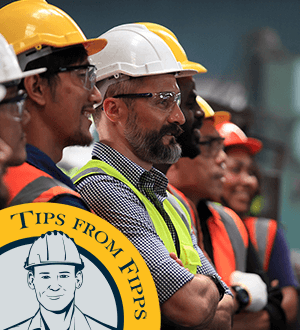Tips from Fipps: Be Your Own Safety Superhero

Ensuring a safe and secure work environment is a shared responsibility that each one of us plays a crucial role in. However, never assume that someone else is as invested in your safety as you are. By taking personal responsibility for our own safety, we contribute to a workplace culture that prioritizes well-being and fosters a positive atmosphere. More importantly, we make it home safely every day to the ones who depend on us.
Taking personal responsibility for your own safety in the workplace is crucial for several important reasons:
- Preserve Your Well-Being: Prioritizing safety helps ensure your physical and mental well-being. By taking responsibility, you actively contribute to creating a safer environment for yourself and your colleagues.
- Empowerment: Assuming personal responsibility empowers you to be proactive about identifying and addressing potential hazards. It gives you a sense of control over your own safety, fostering a positive and proactive mindset.
- Prevent Accidents: Being vigilant and adhering to safety guidelines significantly reduces the risk of accidents. Taking personal responsibility means actively avoiding behaviors or actions that could lead to harm, preventing injuries and incidents.
- Set an Example: When individuals take personal responsibility for their safety, it sets a positive example for others. It contributes to the development of a safety-conscious culture within the workplace, where each team member values and prioritizes their well-being.
- Financial Stability: Workplace accidents can be costly. Medical expenses, lost time, legal fees, and more can be a heavy financial burden for most families, even when employers bear the brunt of the cost. When everyone actively engages in safe practices, the overall risk of accidents decreases. Less accidents mean less injuries, and fewer medical bills.
- Contribute to Team Morale: A safe and secure work environment positively influences team morale. When each team member takes responsibility for their safety, it creates a sense of trust and camaraderie, fostering a more positive and collaborative workplace culture.
- Comply with Regulations: Many workplaces are subject to safety regulations and standards. Taking personal responsibility ensures compliance with these guidelines, helping the organization meet legal requirements and maintain a reputation for responsible and ethical practices.
- Enhance Productivity: A safe workplace is a productive one. When employees feel secure, they can focus on their tasks without unnecessary worry about potential hazards. This focus contributes to increased productivity and overall job satisfaction.
- Adapt to Changing Conditions: Personal responsibility involves staying informed about safety protocols and adapting to changing conditions. Whether it's new equipment, procedures, or workplace layouts, being aware and adaptable ensures that safety remains a priority.
- Long-Term Career Sustainability: Prioritizing safety is an investment in your long-term career sustainability. A safe work history contributes to a positive professional reputation and increases your employability, as employers value individuals who take responsibility for their well-being and that of their colleagues.
 Protect Yourself
Protect Yourself
Taking personal responsibility for your own safety is not only a commitment to your individual well-being but also a contribution to the overall health and success of the workplace. It's an integral part of being a responsible and conscientious team member. Be proactive about keeping yourself safe.
Know Your Surroundings: Familiarize yourself with your work area and identify potential hazards. Report any concerns to the appropriate channels, ensuring prompt resolution and maintaining a hazard-free zone.
Be Mindful of Ergonomics: Take care of your physical health by paying attention to ergonomics. Adjust your chair, monitor, and keyboard to reduce the risk of strains and injuries. Regular breaks and stretching can also make a significant difference to your well-being.
Utilize Personal Protective Equipment (PPE): Always use the provided PPE for your specific role. Whether it's gloves, safety glasses, or helmets, wearing the right protective gear significantly reduces the risk of accidents and injuries.
Report Incidents Promptly: If you witness or experience any safety concerns, report them immediately. Quick reporting allows for swift action, preventing potential hazards from escalating and ensuring a safer workplace for everyone.
Attend Safety Training Sessions: Participate actively in safety training sessions organized by the company. Stay informed about new safety protocols, procedures, and best practices. Knowledge is a powerful tool in preventing accidents.
Foster a Culture of Open Communication: Encourage open communication about safety concerns with your colleagues and supervisors. A culture of transparency helps identify potential issues early on, fostering a collaborative effort to maintain a safe work environment.
Take Breaks and Manage Stress: Fatigue and stress can compromise our ability to stay alert and make safe decisions. Prioritize breaks and manage stress effectively to ensure you're always operating at your best, both mentally and physically.
Remember, safety is not just a set of rules; it's a mindset. Your employer is financially, ethically, and morally obligated to keep you safe. But you are the most active participant in your own workplace safety. Protect yourself. You are the only one of you.
Stay safe and take care.
Related Resources

9 Tips for Effective Safety Messaging to Prevent Common Injuries
Organizations are required under the OSHA General Duty clause to provide a working environment "free from ...
Read
Tips From Fipps: It Pays to Be Safe, The Business Case for Workplace Safety
Workplace safety is not only crucial for protecting employees' well-being but also for the overall success of ...
Read.png)
Get the Most Out of Toolbox Talks: Workplace Safety and Communication
What Are Toolbox Talks? Toolbox Talks, short safety meetings typically held at the job site before the ...
Read.png)





